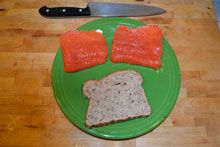Fish Consumption Calculator
What is a Fish Consumption Rate?
A fish consumption rate is an estimated amount of fish (finfish and shellfish) eaten over a specific period of time. Rates are often developed based on the diet of an individual or group of people with similar characteristics. It is frequently measured as grams or ounces per day.
Why are fish consumption rates important?
Fish consumption rates are used for developing water quality standards, contaminated site clean-up levels, and other actions that consider how one’s diet may affect human health. A very basic way to calculate your personal fish consumption rate is by using a calculator. Using the calculator is simple:
- Determine how often you eat fish
- Consider the standard portion size of the fish you generally eat.
- Press "Calculate!" and your personal fish consumption rate will be calculated in grams per day.
Note that this tool provides you with a value that assumes you eat the same amount of fish every week throughout the year. Try using the calculator in a variety of ways to account for differences throughout the year. Typically, Alaskans eat more fish during certain times of the year depending on the availability of fresh items.
Portion Sizes
~28 grams or 1 oz

~85 grams or 3 oz

~255 grams or 9 oz

~170 grams or 6 oz

NOTE: The portion weight should be based on an uncooked amount
Fish Consumption Calculator
Many Alaskans vary their fish consumption from season to season. Below is just one example of how seasonal preferences can differ. If you want to try and estimate your yearly total based on seasonal preferences, try this approach:
| Example Only | |||
| Spring (Apr-June) | Summer (July-Sept) | Fall (Oct-Dec) | Winter (Jan-March) |
|---|---|---|---|
| 2-3 times per week Large Serving (255g) |
6+ per week Large Serving (255g) |
4-5 times per week Large Serving (255g) |
2-3 times per week Large Serving (255g) |
| 91.8 | 255 | 163.2 | 91.8 |
| Average of all four seasons (Add value of each season and divide by four) | 150.45 g/day (year avg) | ||
Now that I know how much I might consume, what does this mean to me?
DEC is in the process of updating the criteria used for protecting human health from certain toxic chemicals potentially found in water. Since fish swim in water, a fish consumption rate is used, in part, to determine how much exposure to certain chemicals a person may experience through their dietary choices. There has been a great deal of debate regarding the most appropriate value to use. In 2015 the Environmental Protection Agency (EPA) published national fish consumption rate of 22 g/day for the general population (nationwide) and 142.4 g/day for subsistence uses. These values are based on a nationwide dietary study. This value does not reflect that certain populations may eat more fish and other aquatic life or include the consumption of salmon, halibut, crab, or other marine species.
DEC understands that these values may not represent fish consumption in Alaska. DEC is now collecting data in an effort to revise Alaska’s fish consumption rate to reflect the amount of fish that may be consumed by residents. DEC plans to make a decision on this issue and develop draft rulemaking language in 2017. For more information on this project, please visit:
Human Health Criteria and Water Quality Standards
How safe are the fish I consume?
DEC is concerned about Alaska's natural resources and the health of the residents of the state. Consequently, the Fish Tissue Monitoring Program (FTMP) was established to determine the presence of bioaccumulative contaminants in Alaska's fishes and monitor trends in the levels of those contaminants in fish tissue. Important commercial, recreational, and subsistence fish and shellfish species are analyzed for trace metals (methyl mercury, total mercury, arsenic, selenium, copper, lead, cadmium) as well as persistent organic pollutants (POPs) such as: dioxins and furans, organochlorine pesticides, PCB congeners, brominated fire retardants, personal care products, and pharmaceuticals. This program works to ensure these resources are safe and to provide relevant information to users to make informed decisions. Multiple species important to commercial, sport, and subsistence users are tested. The analyses thus far have not found high levels of contaminants that would raise concern for most of Alaskan fish. These data were essential to updating the State of Alaska fish consumption advisory in 2014.

 Indicates an external site.
Indicates an external site.